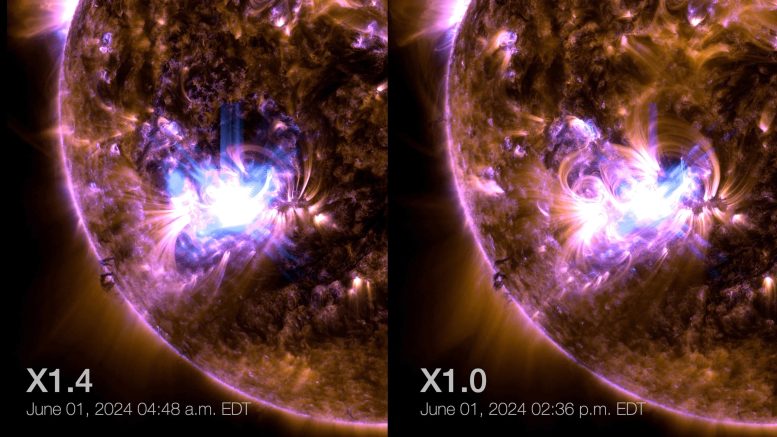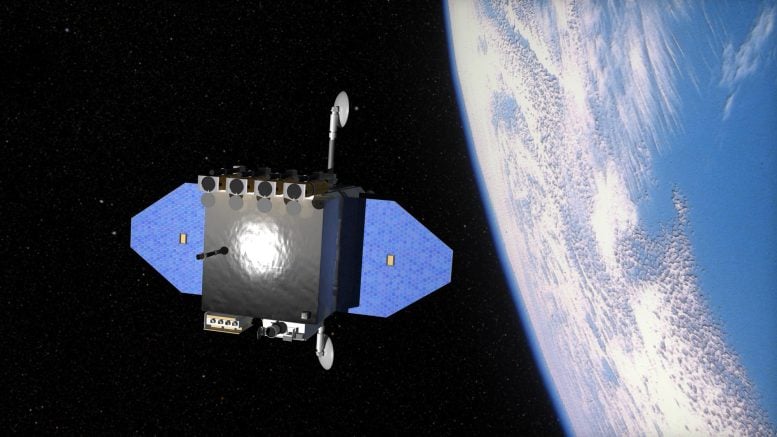NASA’s SDO Captures Dual X-Class Solar Flares


NASA’s Solar Dynamics Observatory captured these images of two solar flares – seen as the bright flashes near the center of the images – on June 1. The images show a subset of extreme ultraviolet light that highlights the extremely hot material in flares and which is colorized in blue and gold. Credit: NASA/SDO
NASA documented two intense solar flares on June 1, 2024, which could affect communications and power systems on Earth.
On Saturday, June 1, 2024, the Sun emitted two powerful X-class solar flares. The first was classified as an X1.4 flare and peaked at 4:48 a.m. ET. The second, which was classified as X1.0, peaked at 2:36 p.m. Images of both events were captured by NASA’s Solar Dynamics Observatory, which is continually monitoring the Sun.
Solar Flares
Solar flares are powerful bursts of radiation that emanate from the Sun, particularly from its active regions around sunspots where magnetic fields are intensely concentrated. These flares occur when built-up magnetic energy is suddenly released in the form of radiation across virtually the entire electromagnetic spectrum—from radio waves to x-rays and gamma rays.
The intensity of solar flares is classified into three categories: C, M, and X, with C being the weakest and X the strongest. Each category has a scale from 1 to 9, which further quantifies the flare’s power. X-class flares can cause significant disruptions on Earth, affecting satellite communications, navigation systems, and power grids.
Solar flares are often associated with coronal mass ejections (CMEs), another form of solar activity where billions of tons of solar particles are ejected into space. This can lead to geomagnetic storms that might produce spectacular auroras, or northern and southern lights, when interacting with Earth’s magnetic field.
Understanding solar flares is crucial for predicting space weather events, which helps in preparing and protecting technological systems and infrastructure on Earth from the potential adverse effects of these solar phenomena.
NASA’s Solar Dynamics Observatory
NASA’s Solar Dynamics Observatory (SDO) is a mission dedicated to understanding the Sun’s influence on Earth and Near-Earth space by studying the solar atmosphere on small scales of space and time and in many wavelengths simultaneously. Launched on February 11, 2010, SDO is a part of NASA’s Living with a Star (LWS) program.
The observatory is equipped with a suite of instruments that provide observations leading to a more complete understanding of the solar dynamics driving variability in the Earth’s environment. One of the primary instruments onboard, the Atmospheric Imaging Assembly (AIA), captures high-resolution images of the solar corona and chromosphere in multiple wavelengths to better understand the output of solar radiation and its impact on our atmosphere.
Another crucial instrument, the Helioseismic and Magnetic Imager (HMI), maps solar magnetic fields and peers beneath the sun’s opaque surface using helioseismology to detail the interior solar dynamics. The Extreme Ultraviolet Variability Experiment (EVE), meanwhile, measures the sun’s ultraviolet output with unprecedented accuracy, which is crucial for understanding changes in Earth’s ionosphere and thermosphere.
By providing a nearly continuous stream of data, SDO plays a crucial role in our ability to forecast space weather events, aiding efforts to mitigate their effects on space-borne and ground-based technological systems. SDO’s detailed observations are instrumental in advancing our knowledge of the Sun’s atmospheric activities and their impacts on space weather.



